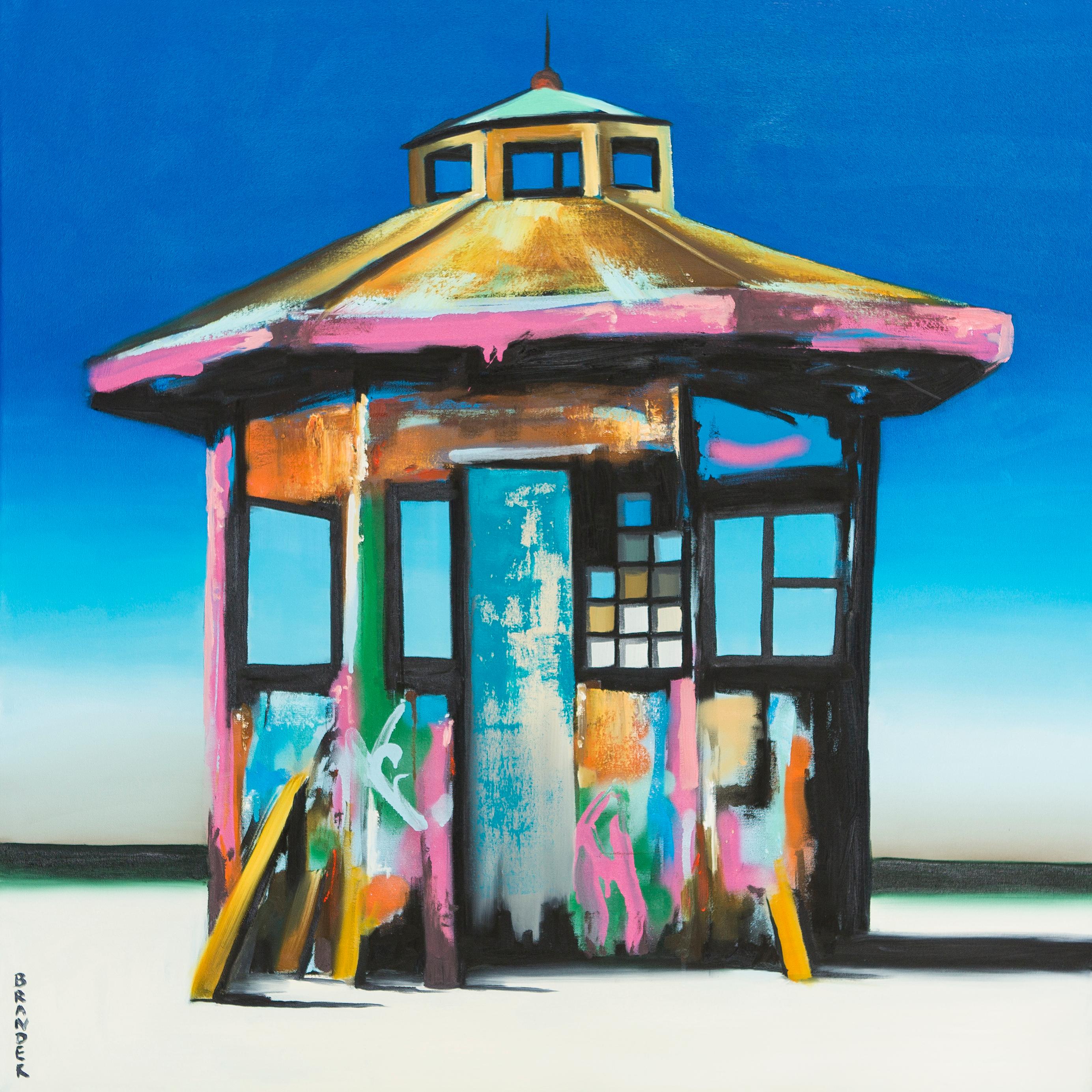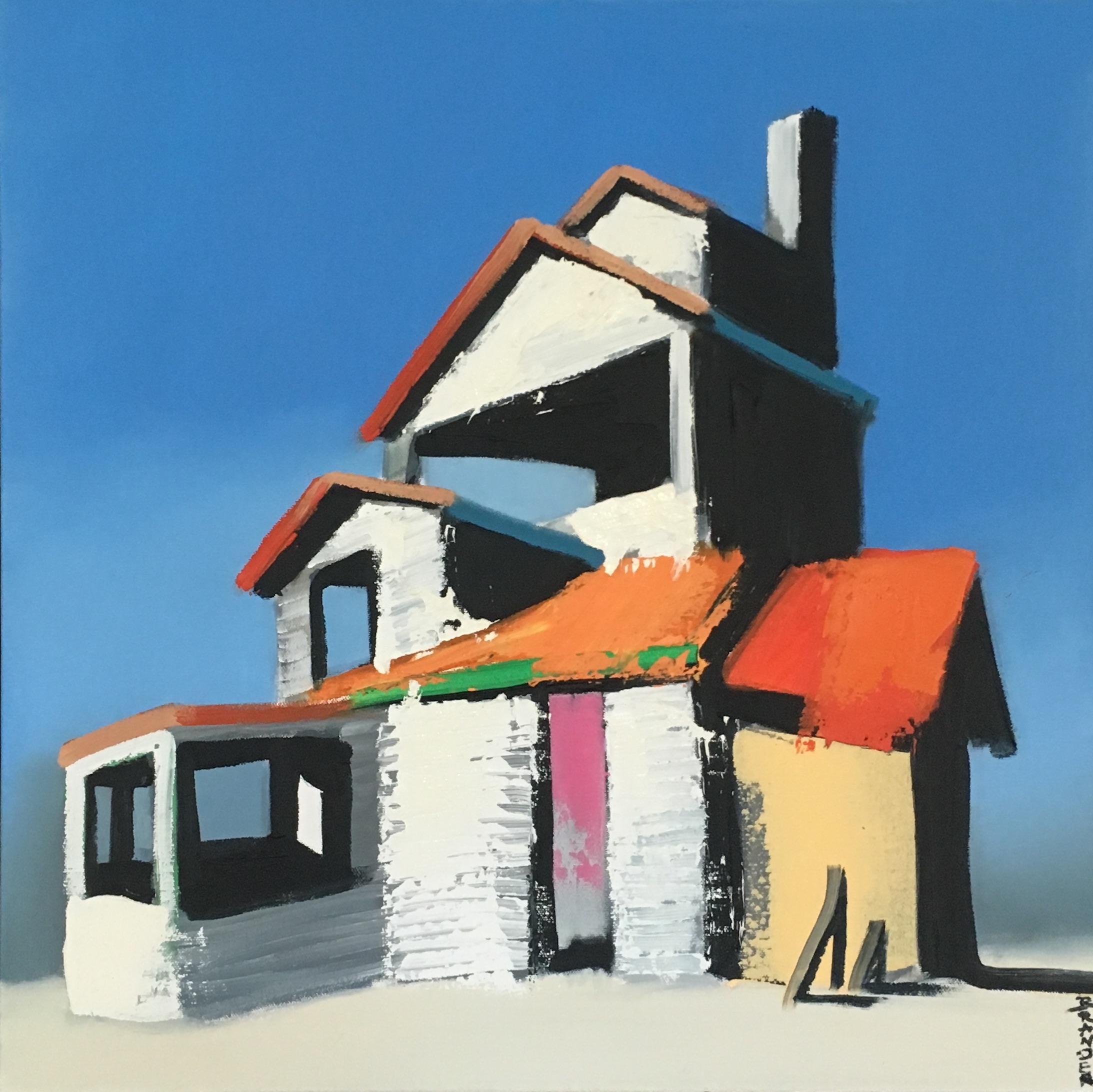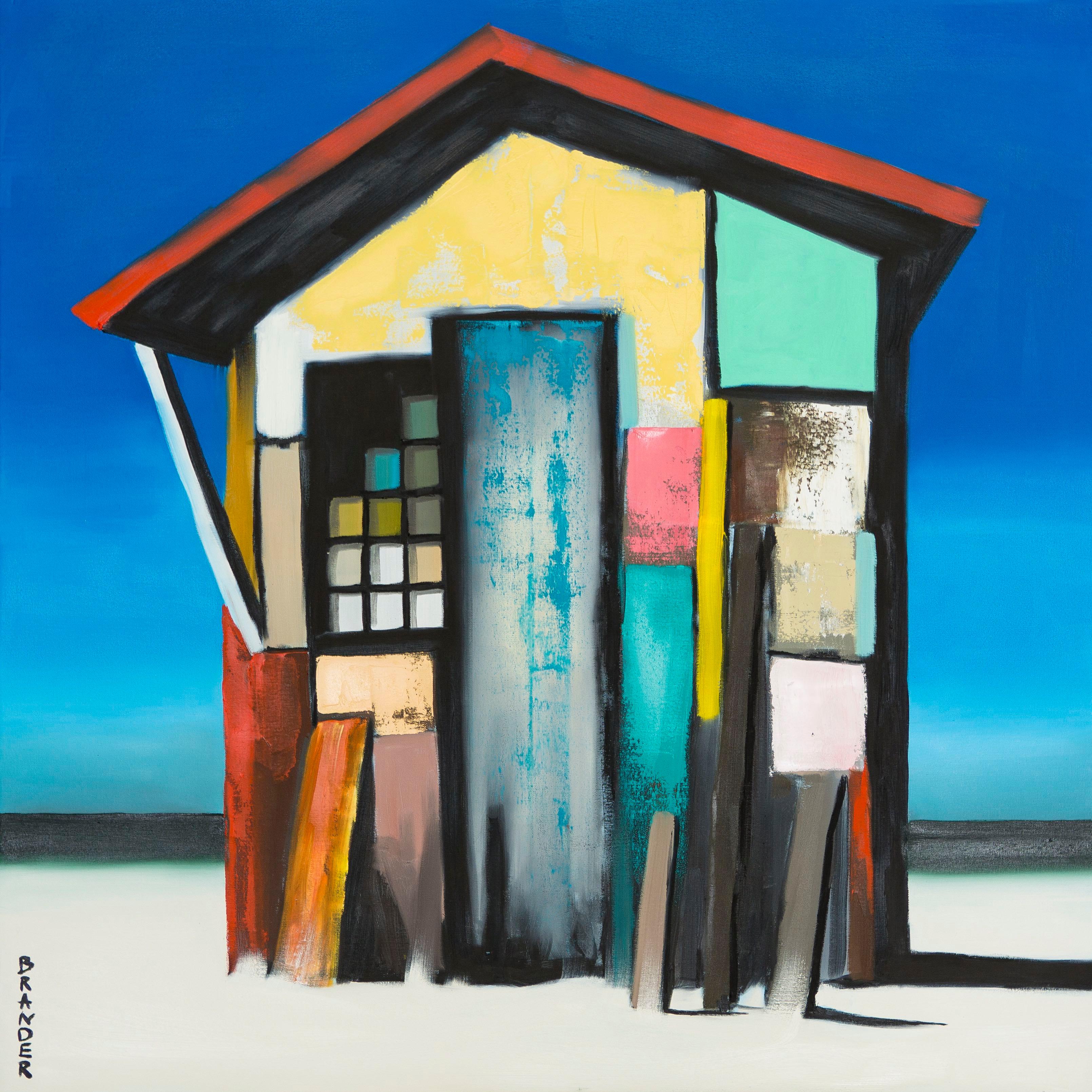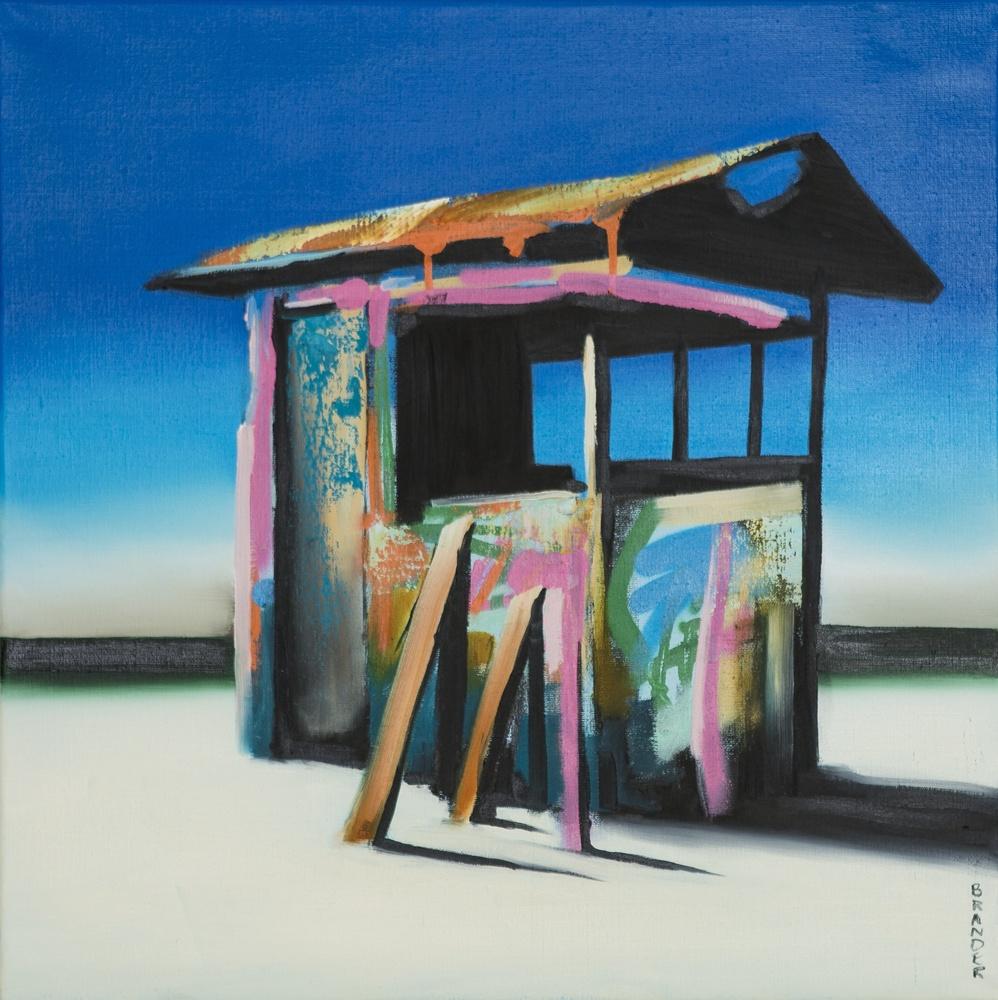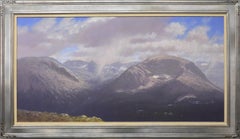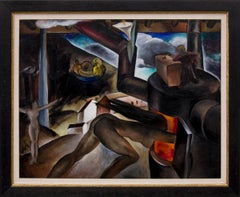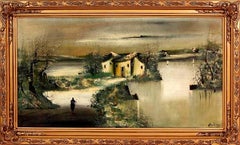Moraine Park at Sunset (Estes Park)
View Similar Items
Want more images or videos?
Request additional images or videos from the seller
1 of 6
Charles Partridge AdamsMoraine Park at Sunset (Estes Park)circa 1900
circa 1900
About the Item
- Creator:Charles Partridge Adams (1858-1942, American)
- Creation Year:circa 1900
- Dimensions:Height: 14 in (35.56 cm)Width: 20 in (50.8 cm)
- Period:
- Condition:
- Gallery Location:Denver, CO
- Reference Number:Seller: 190711stDibs: LU273102854
Charles Partridge Adams
Born in Franklin, Massachusetts, Charles Partridge Adams moved with his mother and two sisters to Denver, Colorado, in 1876 in an effort to cure the two girls who suffered from tuberculosis. In Denver, Adams found work at the Chain and Hardy Bookstore. He received his first, and only, art training from the owner's wife, Helen Chain. Mrs. Chain, a former pupil of George Inness, provided instruction and encouragement to the young artist and introduced him to other artists in the area including Alexander Phimister Proctor. Proctor and Adams developed a friendship and the pair embarked on a three-month camping trip in Egeria Park, Colorado. In addition to exploring, both artists did quite a bit of sketching on the trip. After their return to Denver, Adams and Proctor shared a studio for a short period of time before Proctor moved to New York. Adams remained in Denver and after a short stint as an art teacher he studied wood engraving with Major J.M. Bagley. He quickly abandoned the engraving for health reasons and began working in crayon. His business card read "Landscapes and Crayon Portraits" though he much preferred landscapes. The artist soon made a name for himself in Denver. He established a wealthy clientele that purchased a number of his paintings to decorate their homes and to give as Christmas gifts. In 1890, Adams married Alida Joslin Reynolds and the couple honeymooned in Estes Park, Colorado. That same year, he exhibited for the first time at the National Academy of Design. Three years later, the artist opened his first studio on Larimer Street in Denver. He began working in watercolor and had success in the new medium selling his paintings in stores in Colorado Springs, Pueblo, Kansas City, and Chicago. Also in 1893, Adams became a charter member of the Denver Artists Club. In 1905, the couples dream of living in Estes Park was realized when Adams completed construction on a home and studio there. Adams referred to the studio as "The Sketch Box" and the family spent summers there every year. Though Adams is best known for his Colorado landscapes, he also painted in Yellowstone, the Tetons, the Canadian Rockies, the New Mexican Desert, and California. In 1914, the couple sailed to Europe where they spent five months touring. Three years later, Charles suffered from a near-fatal illness. In 1920, Adams moved to California where he opened a studio first in Pasadena and later in Laguna Beach. He became a member of the Laguna Beach Artists Association and began painting marine subjects. ©David Cook Galleries, LLC
About the Seller
5.0
Platinum Seller
These expertly vetted sellers are 1stDibs' most experienced sellers and are rated highest by our customers.
Established in 1979
1stDibs seller since 2013
265 sales on 1stDibs
Typical response time: 3 hours
More From This SellerView All
- 1945 Abstract Landscape with Waterfall Watercolor Painting, Modernist LandscapeBy Eve DreweloweLocated in Denver, COWatercolor on paper painting by Eve (Van Ek) Drewelowe titled "The Champagne Cascades, Crescendos, Crashes" from 1945. An abstract landscape scene of a waterfall with white, yellow, and black. Presented in a custom gold frame, outer dimensions measure 43 ¾ x 33 ¾ x ½ inches. Image size is 29 ¾ x 19 ¾ inches. Painting is clean and in very good vintage condition - please contact us for a detailed condition report. Provenance: Private collection, Denver, Colorado Expedited and international shipping is available - please contact us for a quote. About the Artist: A painter and sculptor, Eve Drewelowe was the eighth of twelve children and grew up on a farm with a tomboyish spirit. Her farm duties did not permit her to take art classes in her youth that she later felt would have hindered the development of her artistic style. Although her father died when she was eleven, he imparted to her reverence for nature and a true love of the earth, values later reflected in her western oil and watercolor landscapes. She attended the University of Iowa at Iowa City on scholarship, receiving her B.A. degree in graphic and plastic arts in 1923. After graduation and against the advice of her art professor, Charles Atherton Cumming who believed that matrimony ended a woman’s painting career, she married fellow student Jacob Van Ek. While he pursued his doctorate in political science, she enrolled in graduate school at the University of Iowa for her M.A. degree in painting and the history of art. At that time her alma mater was one of the few universities in the United States offering an advanced fine arts degree, and she was its first graduate, receiving her degree in 1924. That year the Van Eks moved to Boulder, Colorado, where Jacob had obtained a position as an assistant professor at the University of Colorado. Five years later he became the Dean of the College of Arts & Sciences, a position he held until 1959. Eve briefly studied at the University. In 1927 and 1928 she taught part-time at the University’s School of Engineering and a decade later summer courses (1936 and 1937) in the University’s Department of Fine Arts. In 1926 she became a charter member of the Boulder Artists Guild and participated in its inaugural exhibition. Like many American artists of her generation, she helped foster an art tradition outside the established cultural centers in the East and Midwest. Her professional career spanning six decades largely was spent in and around Boulder. There she produced more than 1,000 works of art in oil, watercolor, pen and ink, and other media in styles of impressionism, regionalism, and abstraction. She devoted a considerable part of her work to Colorado, Wyoming, and Arizona subject matter depicting colorful and fantastic landscapes pulsating with energy and untouched by humans. Excited by what she saw, the wide open spaces made her feel like a modern-day pioneer. In discussing her work, she once said, “What really motivated me in my youth, in my growth, in maturity was my desire to captivate everything. I put on canvas an eagerness to possess the wonder of nature and beauty of color and line – to encompass everything, not to let anything escape.” Before World War II she and her husband took two international trips that had far-reaching consequences for her career, exposing her to the arts and cultures of countries in Asia and Europe. The first in 1928-29 was an extensive excursion in the Far East for which her husband had received a scholarship to study and report on the socioeconomics of Japan, Korea, China, the Philippines, the Dutch East Indies and India. The year after their return she had her first solo show at the University of Colorado’s library gallery. Discussing the twenty-six oils and sixteen ink drawings on view representing sixteen different countries, the Christian Science Monitor reviewer noted: “The pictures have a wide range and are far from being stereotyped in subject matter, being personal in choice. The ink-brush drawings are spontaneous, well balanced, and striking in their masses, giving the sense of having been done on the spot.” Her second trip with her husband and a party from the Bureau of University Travel had a four-month itinerary that included England, Denmark, Finland, Russia, Turkey, Greece, Italy, and France. It yielded seventeen oils and twenty-six ink-wash drawings which she exhibited in a February 1936 solo show at the Boulder Art Association Gallery. Her creative output in the 1930s attracted the attention of the critic for the Parisian Revue des Arts whose observations were translated and printed in the Boulder Daily Camera on June 10, 1937: To present our readers Eve Van Ek [at that time she signed her work with her married name] …is to give them an opportunity to admire a talent of multiple aspects. The eclecticism of her art passes from a rich skill in forceful oil painting of fine strokes of precision best seen perhaps in her treatment of mountain subjects, of craggy cliffs hewn as in nature, through pen and ink or lithographic crayon design, water color, and occasionally embroidery and sculpture, to the delicate perfection of detail of the miniature. The lofty mountains of Colorado have supplied her with extremely interesting subjects for study; she knows how to represent in an entirely personal way the varying scenes and the curious restlessness of the terrain. While pursuing her art, she also was a dean’s wife. The responsibilities attached to that position proved too restrictive, contributing to a grave illness. She underwent an operation in 1940 at the Mayo Clinic for a gastric polyp, a dangerous procedure at that time. Although she had expected to come back to Boulder “in a box,” the surgery proved successful. Depicting her painful hospital stay in a watercolor, Reincarnation, she reflected on the transformative experience of piecing her life back together. That October she received encouragement from the review of her solo exhibition at the Argent Gallery in New York written by Howard Devree, art critic for the New York Times who said: “The whole exhibition is stimulating…Boats, fences and even flowers in the canvases of Eve Van Ek…seem struggling endlessly to escape from the confines of the frame.” Her watercolor, Crosses, Central City (1940), illustrates her work described in the New York review. The composition pulsates with energy conveyed by the modernist technique of juxtaposing the scene’s various angles, distorting the shapes and positions of the structures, additionally highlighting them with bright colors. The telephone poles at various angles represent crosses figuratively marking a Way of the Cross symbolized by the wooden stairs...Category
1940s Abstract Landscape Paintings
MaterialsPaper, Watercolor
- Terra Tomah Mountain, Rocky Mountain National Park, Colorado, Landscape PaintingLocated in Denver, COOil painting on linen by Denver artist Raymond Knaub (born 1940) titled "Terra Tomah Mountain - Rocky Mountain National Park, Colorado". Presented in a c...Category
20th Century American Realist Landscape Paintings
MaterialsLinen, Oil
- Surrealist Female Nude in Industrial Landscape Oil Painting, 1930s ModernBy Virginia TrueLocated in Denver, COOil on board. Surrealist/Modernist painting with a female nude reaching into a wood burning stove, hilly landscape with barn, houses, still life with a bowl of fruit, stormy sky and a small male figure. Presented in a custom frame, outer dimensions measure 29 ¼ x 35 x ¾ inches. Image size is 24 ¼ x 30 inches. Provenance: Private Collection, Colorado About the Artist: The daughter of a classically-trained pianist mother and a concert violinist father, she had an intellectually stimulating upbringing enhanced by Christian Science values. After graduation from high school in Hannibal, Missouri, she enrolled in the College of Education at Butler University in Indianapolis, Indiana in 1919. Soon, however, she gave up the idea of becoming a teacher and entered at the John Herron Art Institute (whose collections are now part of the Indianapolis Museum of Art). The Institute’s early faculty included artists from the Hoosier Group trained at the Royal Academy in Munich, Germany, who educated artists in the realist tradition. True’s teacher and mentor, William Forsyth, gave her an excellent foundation in drawing and the technical aspects of painting and composition. When the failure of her father’s business in the early 1920s forced her to start earning a living, the Herron Institute hired her as an instructor for its art school, allowing her to support herself while she finished her studies. Following graduation from the Institute in 1925, she received a one-year scholarship to the Pennsylvania Academy of the Fine Arts in Philadelphia. Her former teacher William Forsyth wrote in his recommendation: "I can say without exaggeration that she was one of the best pupils I ever had during the twenty-five years I was a teacher at the John Herron Art School." At the Academy, she studied with Daniel Garber, an impressionist landscape painter associated with the New Hope art colony, and Hugh Breckenridge noted for his bold palette and expressionistic use of color, as well as the abstract work he started doing by 1922. She also studied briefly in the art department at Columbia University, perhaps in1928 when she produced some of her New York street scenes. From Pennsylvania, she returned to Indiana teaching for several years at Shortridge High School in Indianapolis. She also began showing her work at several area venues, including the Herron Institute, the Artists of Indiana, and the Hoosier Salon held early on in Chicago. Among the Salon’s exhibitors were Gustave Baumann, Victor Higgins, and Olive Rush, who either were Indiana natives or whose careers included connections with the state. By the 1920s all three of them had become associated with the Santa Fe and Taos art colonies. In the summer of 1928 True experienced both New Mexico communities and Southwest culture firsthand with Francis Hoar and her husband Clement Trucksess, her friends from the Herron Institute. They had relocated to Boulder in 1927 and were teaching at the University of Colorado. She recorded in her journal her initial reaction to the New Mexico landscape: "Might I preserve on canvas my thrill and deep feeling of the grand things of nature I have beheld today….There’s a wideness in God’s country that expresses peace to me." Inspired by her trip, True created a group of watercolors for her solo exhibition in 1928 at the Lieber Gallery in Indianapolis. They marked a transition from the realist style she learned at the Herron Institute to the more modernist, semi-abstract one she soon adopted. In the summer of 1929, she accepted an instructor’s position on the faculty of the Fine Arts Department at the University of Colorado (CU) in Boulder. She after that joined the Art Association of Boulder founded in 1923 by Mrs. Jean Sherwood, an art patron and club woman who relocated from Chicago to teach at the Boulder Chautauqua. Sherwood helped convince Dean Fred B...Category
1930s Surrealist Figurative Paintings
MaterialsOil
- Sangre de Cristo Scene, Framed Taos New Mexico Mountain Landscape Oil PaintingBy Georgina KlitgaardLocated in Denver, COOriginal signed oil painting by Georgina Klitgaard (1893-1976), a Taos, New Mexico mountain landscape painting with figures walking in a meadow with ...Category
20th Century American Impressionist Landscape Paintings
MaterialsCanvas, Oil
- Mountain Landscape, Colorado Springs, Colorado, Framed Landscape Oil PaintingLocated in Denver, COMountain Landscape, Near Colorado Springs, Colorado is a vertical oil on board painting by Mary Cane Robinson. Presented in a custom frame, outer dime...Category
Mid-20th Century American Modern Landscape Paintings
MaterialsOil
$3,563 Sale Price24% Off - Ed Sketching at Red Rocks, Vintage 1940s Original Mountain Landscape, ColoradoBy Vance KirklandLocated in Denver, COOriginal vintage 1940s Modernist Landscape painting of Red Rocks Park, Colorado by Vance Kirkland (1904-1981). Titled, "Ed (Hicks) Sketching at Red Rocks". This regionalist mountain landscape painting is set near Red Rocks Park, Morrison, Colorado (just west of Denver). The figure in the painting is of Kirkland's friend, Ed Hicks. Watercolor on paper, signed and dated, January 1943, lower left and titled verso by the artist. Painted in colors of red, brown, blue, and green. Presented in a custom gold leaf frame, outer dimensions measure 34 ¾ x 42 ⅞ x 1 ¼ inches. Painting as shown within the mat and frame measures 21 x 29 inches. Provenance: Private Collection, Denver, Colorado About the Artist: Variously referred to as the “Father of Modern Colorado Painting,” “Dean of Colorado Artists” and “Colorado’s pre-eminent artist,” Kirkland was an inventive, visionary painter who spent fifty-two years of his fifty-four year career in Denver. Of the approximately 1,200 paintings he created, about 550 from the first half of his career (1927-1953) are water-based media: acquarelle, gouache, casein and egg tempera, with a few oils. In the latter half of his career (1953-1981) he used oil and his unique oil and water mixture. He also produced five hundred drawings and some ten prints, mostly lithographs on stone, while also engaged in teaching full-time for most of the period. To show people “something they have never seen before and new ways to look at things,” he felt he needed to preserve his artistic freedom. Consequently, he chose to spend his entire professional career in Denver far removed from the established American art centers in the East and Midwest. “By minding my own business and working on my own,” he said, “I think it was possible to develop in this part of the country… I’ve developed my kind of work [and] I think my paintings are stronger for having worked that way.” The geographical isolation resulting from his choice to stay in Colorado did not impede his creativity, as it did other artists, but in fact contributed to his unique vision. The son of a dentist, who was disappointed with his [son’s] choice of art as a career, Kirkland flunked freshman watercolor class in 1924 at the Cleveland School of Art (now the Cleveland Institute of Art) for putting colors into his landscapes that did not exist in nature and for competing colors. Not dissuaded, he won first prize for his watercolors in his junior and senior years. [While in Cleveland,] he studied with three influential teachers. Henry Keller, included in the prestigious New York Armory Show in 1913, introduced him to designed realism which he later used in his Colorado landscapes in the 1930s and 1940s. His other teachers were Bill Eastman, who studied with Hans Hofmann and appreciated all the new movements in modern art, and Frank Wilcox, a fine watercolorist. While a student at the Cleveland School of Art, Kirkland concurrently took liberal arts courses at Western Reserve and the Cleveland School of Education and taught two freshman courses in watercolor and design, receiving his diploma in painting from the school in 1927 by doing four years of work in three. The following year he received a Bachelor of Education in Art degree from the same institution. In 1929 he assumed the position of founding director of the University of Denver’s School of Art, originally known as the Chappell School of Art. He resigned three years later when the university reneged on its agreement to grant its art courses full recognition toward a Bachelor of Arts degree. His students prevailed on him to continue teaching, resulting in the Kirkland School of Art which he opened in 1932 at 1311 Pearl Street in Denver. The building, where he painted until his death in 1981, formerly was the studio of British-born artist, Henry Read, designer of the City of Denver Seal and one of the original thirteen charter members of the Artists’ Club of Denver, forerunner of the Denver Art Museum. The Kirkland School of Art prospered for the next fourteen years with its courses accredited by the University of Colorado Extension Center in Denver. The teaching income from his art school and his painting commissions helped him survive the Great Depression. The U.S. Treasury Department’s Section of Fine Arts commissioned from him two post office murals, Cattle Roundup (1938, Eureka, Kansas), and Land Rush (1940, Sayre, Oklahoma). He also did murals for several Denver clients: the Gerald Hughes mansion (1936, later demolished), Arthur Johnson home (1936-37, Seven Drinks of Man), Albany Hotel (1937, later demolished), Neustetter’s Department Store (1937, “History of Costume,” three of five saved in 1987 before the building interior was demolished in advance of its condo conversion), and the Denver Country Club (1945, partially destroyed and later painted over). In 1953 the Ford Times, published by the Ford Motor Company, commissioned Kirkland along with fellow Denver artists, William Sanderson and Richard Sorby, to paint six watercolors each for the publication. Their work appeared in articles [about] Colorado entitled, “Take to the High Road” (of the Colorado Rockies) by Alicita and Warren Hamilton. Kirkland sketched the mountain passes and high roads in the area of Mount Evans, Independence Pass near Aspen, and Trail Ridge Road in Rocky Mountain National Park. In 1946 Kirkland closed his art school when the University of Denver rehired him as director of its School of Art and chairman of the Division of Arts and Humanities. In 1957...Category
1940s American Modern Landscape Paintings
MaterialsWatercolor
$15,400 Sale Price20% Off
You May Also Like
- Venice Landscape Italian Oil on Canvas Painting in Gilt Wood Frame, Belle EpoqueLocated in Firenze, ITThis delightful turn of the century (early 20th century) oil on canvas painting represents an Italian landscape with one of the most famous squares in the world: Piazza San Marco in ...Category
Early 20th Century Impressionist Landscape Paintings
MaterialsCanvas, Oil
- Houses And River-Large Impressionist Landscape Oil on Canvas Signed A.HuntingtonLocated in Coimbra, PT"Houses And River" Signed A. Huntington (English School) Oil on canvas Measures: Canvas - 60x110 cm (Gilt Wood Frame - 76x126 cm) Private collection. FramedCategory
Early 20th Century Impressionist Landscape Paintings
MaterialsCanvas, Oil
- French Tempera on Canvas Four Panels Folding Screen with Seascape ViewLocated in Firenze, ITThis French early 20th Century folding screen is made up of four canvases entirely painted with textured tempera featuring a marine l...Category
Early 20th Century Realist Landscape Paintings
MaterialsCanvas, Tempera
- Important 17' Century Mythological Painting Diana and Actaeon Oil on CanvasBy Giovanni Battista ViolaLocated in Rome, ITFascinating mythological story of Diana and Actaeon can be found in Ovid’s Metamorphoses. Very important provenance from a royal collection. Fabulous finely carved gilt wood coeval frame . Giovanni Battista Viola...Category
17th Century Baroque Landscape Paintings
MaterialsOil
- Important 17' Century Mythological Painting Diana and Actaeon Oil on CanvasBy Giovanni Battista ViolaLocated in Rome, ITFascinating mythological story of Diana and Actaeon can be found in Ovid’s Metamorphoses. Very important provenance from a royal collection. Fabulous finely carved gilt wood coeval frame . Giovanni Battista Viola...Category
17th Century Baroque Landscape Paintings
MaterialsOil
- Important 17' Century Mythological Painting Diana and Actaeon Oil on CanvasBy Giovanni Battista ViolaLocated in Rome, ITFascinating mythological story of Diana and Actaeon can be found in Ovid’s Metamorphoses. Very important provenance from a royal collection. Fabulous finely carved gilt wood coeval frame . Giovanni Battista Viola...Category
17th Century Baroque Landscape Paintings
MaterialsOil
Recently Viewed
View AllMore Ways To Browse
Mexican Christmas
J J Adams
J Adams
Yellowstone National Park Art
New Mexico Landscape Sunset
Antique Christmas Gifts
19th Century Mexican Portrait
Canadian Rockies Oil
Teton Mountains
Desert Engravings
Estes Park
Tetons Mountain Painting
Desert Mountain Landscape Watercolor
Partridge Family
Antique Watercolour Paint Box
Antique Watercolour Paint Box Watercolour Paint
Antique Watercolor Paint Box
Oil Paintings Bookstore



